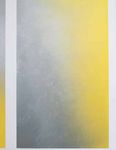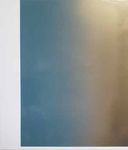Tomek baran - Zak Branicka
←
→
Page content transcription
If your browser does not render page correctly, please read the page content below
Baran operates simultaneously within postindustrial art, abstraction and new media aesthetics. He sometimes uses the notion of the “gradient,”
or movement in computer graphics, the smooth tonal transitions between colors. He thus evokes digital imaging systems, which can be seen
in his golden-white works. As such, his monochromatic, dark painting-objects can also be viewed in terms of digital culture, and thus gain a
wider meaning. They do not bear direct reference to Kazimir Malevich’s Suprematism, but rather to virtual reality, and the symbolism of the “black
mirror.”
The “black mirror” concept has been popularized by the popular British TV show of the same title, which examines modern society, particularly
with regards to the unanticipated consequences of new technologies. It is a show about how these technologies change us and how digital
progress interferes with human nature – developments in media and social media. Our lives are inseparable from and immersed in computer
Black Mirror reality, but when we turn off our phones, tablets, or computer and look at them, we see our reflection in the dark “mirror.” In the black reflective
surface of a digital screen we see a blurred image of ourselves on the other side. This is, in fact, a reflection of the loneliness and isolation of the
digital age and a reflection of our true faces in a social media reality.
Baran works to challenge our sense of materiality. His objects cannot be defined by a single discipline, only by a combination of painting and
sculpture, creating a playful displacement of both. Perhaps the most accurate definition would be that they are ready-mades which often Virtual reality, like the mirror example, is a space that may be called a “heterotopia,” in which images exist, though the space itself does not
evoke a postindustrial mood. Baran uses a blend of materials to create a performance-like space, where the objects work together to form their exist in reality. Baran’s objects, matte and covered with various paints, may be also described as heterotopias. According to Michael Foucault, a
own interventions. The surfaces of his paintings vary from shiny metallic to a concrete matte, encouraging the viewer’s eye to interact with the heterotopia displays a “counter-place,” an irreal space in which we can see ourselves where we’re not. It is a space that simultaneously does and
constructions shaped under the canvas. He focuses on problems of space, and looks for the relation between his own abstract work and that of does not exist, just like the other side of mirror – the space of inverted reality. In this sense, Baran’s monochromatic objects, matte and covered
architecture and sculpture. Growing up in Stalowa Wola, an industrial city in post communist Poland, Baran’s keen aesthetic sense was thirsty for with dark paint, may be also viewed and regarded as heterotopias. As separate artworks and all together as artistic installation, they create a
something different. He chose not to create something new out of refined materials but to repurpose what he knew. feeling of being on the other side of the picture. This equals the experience of being in a place without a place. In this way, Baran‘s paintings,
objects and installations undoubtedly work through intuition and immersion, as if the viewer has found himself within the picture.
Significantly, Baran calls himself an “abstract hooligan.” His work is a subversive game, he takes an ironic stance toward his own work, perceived as
a place of art and non-art, painting and non-painting, surrounding reality and virtual reality. If this is so, the artist seems in fact to be questioning The artist appeals to the viewer’s sensitivity and emotional involvement. Entering the show, we may find ourselves before black mirrors, within
the traditional idea of the abstract as utterly divorced from reality. The natural and artificial lighting, the shadows and shadings working together multiple realities that are simultaneously virtual, abstract, and postindustrial. The exhibition is thus determined by heterotopias, constructions
with the picture objects, undergoing constant change depending on the angle from which a work is viewed. The avant-garde artists claimed of places we can experience without physically being there. As viewers, we can connect with other individuals in these heterotopias, but each
that movement and light destroy static realism in painting. In Baran’s work, movement and light conspire with the abstract forms, becoming person will have his or her own unique experience. Through the symbolism of the “black mirror“ we can finally immerse ourselves, and dive
inseparable components in viewing his work. deeper and deeper into the dynamic and shiny reflections of the dark surfaces of the works of art.
Przemysław Strożek (Polish Academy of Sciences)
Front cover: Heavy Metal, exhibition view at BWA Galeria Sztuki Olsztyn, PL, 2016; photo: Bartosz Górka
Back cover: Artists from Krakow: The Generation 1980–1990 , exhibition view at MOCAK, Krakow, 2016; photo: Rafał Sosin Tomek Baran was born in 1985 in Stalowa Wola, Poland, lives and works in Krakow, Poland. His works have been recently exhibited at ŻAK |
BRANICKA, Berlin (2018), Malatura at Le Guern Gallery in Warsaw (2017), Heavy Metal at BWA Galeria Sztuki Olsztynm (2016), DOUBLE at gallery
Platan in Budapest (2015) as well and Xanax, Strabag Artlounge in Vienna (2013). His selected group exhibitions include The Stefan Gierowski
Lindenstr. 35, 10969 Berlin | +49 30 61107375 | www.zak-branicka.com | mail@zak-branicka.com Foundation in Warsaw, Balzer Pojects in Basel and MOCAK Muzeum of Contemporary Art in Krakow among others. He was awarded the 2012
© ŻAK | BRANICKA and Tomek Baran 2018; concept: Asia Żak Persons and Monika Branicka, cooperation: Sofia Hauser Strabag Artaward International in Vienna, a prestigious prize given to a young artist from the field of painting and drawing.Artists from Krakow: The Generation 1980–1990
exhibition
Composition view
05at(Rozalia
MOCAK, Krakow,2017,
Chladek), 2016;oil
photo: Rafał Sosin
on canvas, 200 × 170 cm Untitled (Orbitowski), 2018, grooved rubber and glue on beaverboard, 86 x 53 cm# 87847f, 2018, enamel and spray on canvas, 140 x 120 cm Yellow-silver, 2018, silicone, acrylic and oil spray on canvas, 157 x 127 cm
Untitled, 2014, enamel on canvas, 205 x 160 cm Heavy Metal, exhibition view at BWA Galeria Sztuki Olsztyn, PL, 2016; photo: Bartosz Górka
#1b234a-21201e-e5e4ec, 2018, enamel and hammerite on canvas, 130 x 97 x 16 cm #d3d4d9-8f9180, 2018, hammerite on canvas, 115 x 90 x 5 cm
You can also read

























































